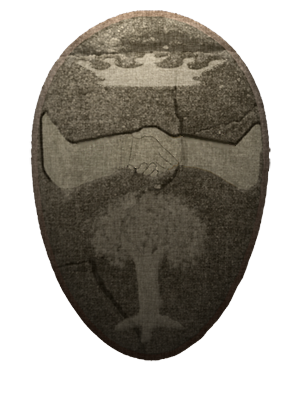









James Fowler CooperJames Fowler Cooper (American 1907-1968)
Cooper was born May 21, 1907, in Williamsburg County, South Carolina. His family ran a farming business and were active in the Presbyterian church. The artist’s childhood years were spent going to school in the town of nearby Kingstree, studying violin, reading and becoming immersed in the day to day life of the farm. At age seventeen Cooper entered the University of South Carolina. Here he took a double major in English and Latin (graduating in 1928 with a Bachelor of Arts), and sang in the university chorus during his leisure-time. More importantly, he also studied art. He was one of the first students to receive a certificate in art from the University, in a program begun in 1925 by Miss Katherine B. Heyward. After graduating in 1928 Cooper went to New York to study at the Art Student’s League, as many aspiring young artists of that day were doing. He took courses with George Bridgman and Boardman Robinson (cartoonist, illustrator, mural painter - a contemporary of Robert Henri, George Luks and John Sloan of the Ash-Can School). New York was very accessible in 1929, even to a person of modest means, and Cooper soaked the city up and thoroughly enjoyed it. He lived at the old West Side YMCA and worked at various odd jobs he could find. Cooper left New York in 1930. His mother, who had been made a semi-invalid with a heart condition since 1923, asked him to come and manage her portion of the business. To his surprise, when he arrived at home he was not welcomed into the business and his mother smilingly said, ‘You can’t farm, Jimmy.’ He did stay at home, however, and got a job in a small bank in Kingstree. He also found he had plenty of free time and began to sketch his surroundings, most especially the people he saw passing through the window. He also spent much time out at Pawley’s Island, which features strongly in his work. It was around this period that Cooper became interested in etching. Etching was attracting considerable attention in Charleston at that time, largely through the efforts of the Charleston Etching Club and Alfred Hutty, who taught for the Carolina Art Association in Charleston every winter and spent his summers working in his studio at Woodstock, New York. Cooper, although influenced by this milieu, was largely a self-taught printmaker. His first etching, ‘Small Plowman’ in 1930/31 was indeed unusually small, even for a miniature. It was about the size of a postage stamp and depicted a farmer following a plough being pulled by a large team of mules. In 1932, Cooper’s mother died after a severe heart attack and he finally took over her position as manager of the family farm. He immediately set about revitalising the business, which had slowly fallen into a state of disrepair and neglect. He read extensively and immersed himself in the latest methods of plant propagation and soil conservation. The primary crops on the Cooper farm were cotton and tobacco. Large amounts of corn were also grown and used as feed for herds of cattle and the hogs. Whatever time was left, the bachelor farmer devoted to his etchings, which he printed on an imported rag paper called Tovil, using an ink that he mixed himself. Cooper exhibited for the first time in 1936, in a show entitled ‘Southern Printmakers’ in Birmingham, Alabama. This was followed by a number of further group and solo shows in the late 1930’s and early 1940’s, perhaps the highlight of which was the inclusion of a print in the New York World’s Fair exhibit of 1939. The overwhelming majority of James Fowler Cooper’s portfolio of prints record scenes of life, labour and landscape in a low-country South-Carolina just before the advent of American involvement in the Second World War. Cooper’s images of this region antedate the major-growth of commercial and industrial enterprises in the state and the accompanying changes wrought by the Southern region’s rapid transition to a prosperous ‘Sunbelt’ economy. By contrast, the world of James Fowler Cooper was an agrarian world, where the daily rhythms were less subject to the tyranny of the clock and the freneticism of the city, but, despite this relative repose, still harboured its own full measure of mystery, tragedy and joy. Much of what Cooper chose to record of the low-country landscape has thankfully been preserved. For example, Charleston and Georgetown’s beautiful churches have survived Civil War, periods of neglect and more recently Hurricane Hugo, remaining central to our sense of the ‘Southern mystique’. Cooper exploits this special ‘sense of place’ in his portrayals of ‘Prince George Winyah’ and ‘St. Philip’s Church’, giving us both light and shade, the glorious and the gothic, a hint of the dual character of the always ambivalent South. Similarly, the magisterial and legendary ‘Live Oak’, with silver-grey trailing wisps of Spanish moss (and hints of both romance and danger) still thrives in the same locations Cooper visited in the 1930’s and ‘40’s. While the plantation houses (seen, for example in ‘Longlands’) and town-houses of the low-country, now form the bed-rock of the region’s tourist appeal.
As with other (albeit briefly) expatriate Southerners of his generation (a certain William Faulkner springs to mind), James Fowler Cooper had to leave the South in order to be able to see it clearly and to see it for the distinctive place it surely was, in contrast to the great metropolis of New York (see ‘The Goldfish Bowl’) where he’d undertaken study at the Art Student’s League. Cooper returned to the South in 1930, the same year that the Twelve Southerners published I’ll Take My Stand: The South and the Agrarian Tradition. His subsequent career as a farmer and artist demonstrate the best qualities of the Southern pastoral tradition championed by the Nashville Agrarians in their anti-industrial manifesto. Cooper eschewed the perils of fame and fortune (‘drinking bouts and literary teas’) and the lure of the city dollar, for a life as a community artist (long before the term became commodified). His values mirror the religious humanistic values of the Twelve Southerners, but unlike them he doesn’t offer such offence on the question of race. Although some might suggest his portrayals of African-Americans occasionally come too close to popular stereotypes (see, ‘Old Man’ and ‘12.30’), it seems fairer to focus on his sincere effort to document the dignity of labour in the black community (see, for example, Tobacco Stringers,’ ‘Threshing Peas’ and ‘Shrimpers’). Indeed, much of Cooper’s work (see, for example, Daddy John’s Place,’ ‘Passed Over,’ Deep South,’ and ‘Back Street, Charleston’) has a documentary honesty that recalls Walker Evans’ Depression-era photographs of the Southern region.
During the years of World War Two and its aftermath, Cooper continued to exhibit his work in regional and national print shows, but with diminishing frequency. Farming and a family (Cooper married in 1941 and two children followed in 1944 and 1946) occupied more of his time. The epitome of the Agrarian artist, Cooper continued to farm his own land throughout his life and died of a heart attack in 1968.
Works |